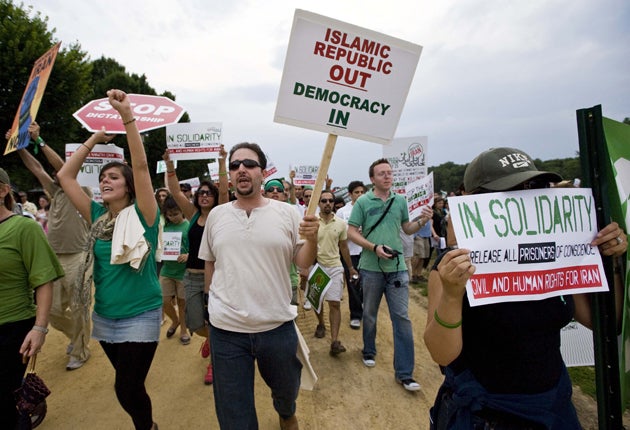World Focus: As Iran protests go global, the regime reacts

Your support helps us to tell the story
From reproductive rights to climate change to Big Tech, The Independent is on the ground when the story is developing. Whether it's investigating the financials of Elon Musk's pro-Trump PAC or producing our latest documentary, 'The A Word', which shines a light on the American women fighting for reproductive rights, we know how important it is to parse out the facts from the messaging.
At such a critical moment in US history, we need reporters on the ground. Your donation allows us to keep sending journalists to speak to both sides of the story.
The Independent is trusted by Americans across the entire political spectrum. And unlike many other quality news outlets, we choose not to lock Americans out of our reporting and analysis with paywalls. We believe quality journalism should be available to everyone, paid for by those who can afford it.
Your support makes all the difference.Protest demonstrations over Iran's presidential election results spread across at least 80 cities in six continents this weekend – with one worrying sign for supporters of defeated presidential candidate Mirhossein Mousavi in Tehran: in several cities, protesters could clearly be seen carrying posters advocating the overthrow of the Islamic Republic. This is something that neither Mousavi nor his supporters have encouraged.
For not one of the original protesters in Iran ever demanded the destruction of Iran's Islamic Republic. They were demanding fairness in elections and a re-run of the poll. But their flag was green and Mousavi himself had for years been a supporter of the principle of a clergy-supervised nation. That the Supreme Leader, Ayatollah Ali Khamenei, should have given his personal support to the declared winner, Mahmoud Ahmedinejad, proves how politically divided the clergy are. Others in Qom are deeply disturbed by this state of affairs. But it does not mean that Mousavi's voters wanted to throw away the fruits of the 1979 revolution against the Shah.
And herein lies the problem. The ruling clerical leadership in Iran and their security accomplices have been trying to persuade the world and the citizens of Iran – and, indeed, themselves – that the Tehran demonstrations were part of a monstrous, foreign-inspired plot organised by all the usual suspects: the CIA, the opposition Mujahedin Qalq (whom even the Americans these days regard as a "terrorist" organisation) and, of course, Britain. The more that Mousavi and his supporters can be painted into a "spy" corner, the more the arrests and beatings and deaths since the 12 June poll – which this weekend's demonstrations were supposed to be about – can be seen as part of a necessary counter-revolutionary operation.
If the regime can use elements of the weekend demonstrations to their advantage – "Down with the Islamic Republic" was one common banner – then they will use this to try to nullify the work of Mousavi and overseas activists like Nobel prizewinner Shirin Ebadi, who told a crowd in Amsterdam that "Iran is our homeland, let us be united."
Mousavi himself has warned that "the [Iranian] security organisations are mysteriously pursuing wrong and fabricated ideas that the activists [in Iran] are tied to foreigners and ... have therefore given way to using illegal, immoral and unethical methods of extracting confessions."
Interestingly, the weekend protesters paid little attention to subjects which respectively obsess the West and put fear into the hearts of Iranians: Iran's nuclear project; and Iranian aircrafts' disturbing habit of falling out of the sky. Manchester University's Manuchehr Sanadjian has identified the whole nuclear fandango as a false "reinvention of national identity", a form of "fetishism" by Ahmedinejad and his friends – was the first piece of processed uranium not placed in a Shiite shrine? – rather than a vast nuclear plot against the West.
At the same time, the ironic collapse of basic avionic technology has drawn attention to the US-supported sanctions (of which a certain Barack Obama used to be such an enthusiast) which prevent the Iranians from properly maintaining their aircraft. The crash of an old Russian Ilyushin plane at Mashad airport on Friday with the loss of 17 lives, and the more devastating crash of another Russian-made plane en route toArmenia on 15th July with 168 passengers and crew killed, concentrates the mind of anyone who approaches the brand-new Imam Khomeini Airport outside Tehran. As usual, the big stick of sanctions politics is wielded over Iran, and the little people pay with their lives.
Join our commenting forum
Join thought-provoking conversations, follow other Independent readers and see their replies
Comments